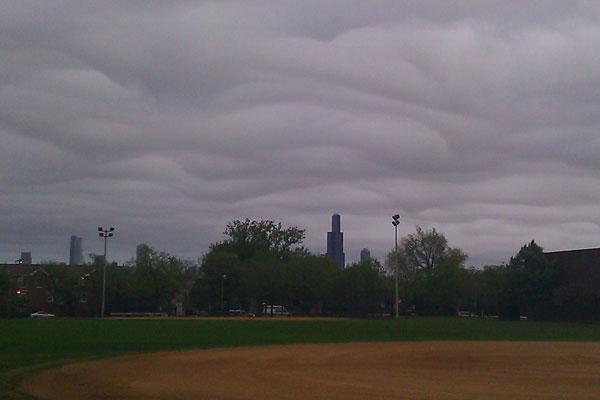
Last night, Facebook and Twitter lit up with pictures of the spectacular hail that briefly fell on the city last night, and sadly wrecked the glass at the Garfield Park Conservatory (update: donate; Soup & Bread is also hosting a fundraiser). Today, it’s clouds. Here’s some video shot by Andrew Huff of Gapers Block:
And a picture by fellow GB’er Phineas X. Jones; and another video; and another picture; and there were many Ghostbusters jokes.
The clouds definitely looked familiar; I took a picture over Smith Park a couple weeks ago of a similar formation, though the clouds aren’t as ragged-looking:

I’d meant to figure out what type of cloud they were, so I started looking. The ones I took are probably altocumulus undulatus. And maybe today’s were, too (here are some more from last year). But apparently not everyone agrees.
In 2009, an undated photograph from Iowa of a "new" type of cloud started making the rounds, one of many received by British cloud enthusiast Gavin Pretor-Pinney of the Cloud Appreciation Society, who said he’s starting getting photographs of the sort around 2005 (here’s a set from 2006). The CAS’s amateur nephologists proposed a new variety: undulatus asperatus. The Royal Meteorology Society took the suggestion for the new variety under advisement:
The Society has agreed to gather detailed weather data on the day and in the location where the asperatus clouds have been seen. Analysis of the meteorological situation will uncover exactly what is causing them. It is likely that the undulating and lumpy underside is caused by warm and cold air meeting at the boundary between the lower and middle atmosphere. It shares some similarities with existing formations such as the more regular waves of undulatus clouds and the hanging pouches of mamma clouds.
If there is evidence to support a new cloud variety then the Society will assist Gavin in applying to the WMO in Geneva to have the new cloud type considered for addition into the International Cloud Atlas.
The official trail on asperatus clouds runs out around 2009, but not before it hit Time‘s "50 Best Inventions of 2009" and Wired, and it’s now Wikipedia– and Flickr-official. I’ve emailed the RMS to see what became of the asperatus.
Photograph: Chicago Tribune


